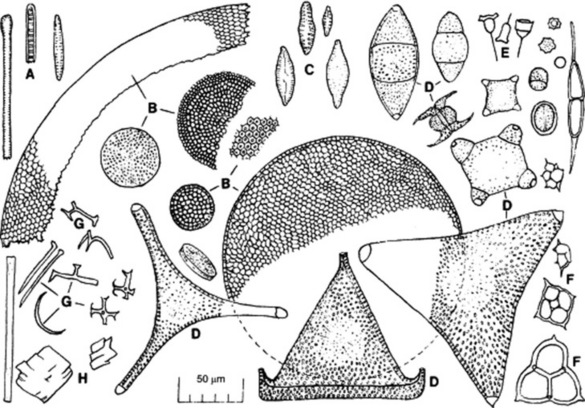Chapter 34 Miscellaneous products
KIESELGUHR OR DIATOMITE
Characters
Purified kieselguhr is a fine, white or pale-buff odourless powder. For microscopical examination it may be mounted in cresol or olive oil. In the latter medium the amorphous silica of the diatoms becomes almost invisible, while the crystalline particles of sand remain clear. Only small amounts of sand (Fig. 34.1H) should be present.
The diatoms (Fig. 34.1) consist of two halves or valves which fit together like a pill-box. The two positions from which they may be studied are known as the valve-view and the girdle-view. The valves show considerable variation in shape, some samples of kieselguhr showing numerous discoid types resembling that of the Arachnoidiscus found in agar, while other samples consist largely of pennate forms. A mixture of both types is usually most suitable for filtration. In many diatoms a median cleft is found in the valves, known as the raphe. The valves also show dots and lines, which vary in the different species and are due to minute cavities in the wall.
PREPARED CHALK
Chalk is a whitish or greyish rock which is widely distributed in north-western Europe. It consists mainly of the shells of unicellular animals known as the Foraminifera. Chalk as quarried often contains about 97 or 98% of calcium carbonate, the remainder being largely siliceous and therefore insoluble in acids. The impure chalk is finely ground with water and freed from most of the heavier siliceous impurities by elutriation. The coarser product is sold as ‘whiting’ and the finer elutriated product is allowed to settle and while still pasty is poured into a funnel-shaped trochiscator. The latter is tapped on a porous chalk slab and ejects the chalk to form ‘cones’, which are allowed to dry giving Prepared Chalk BP. These cones (‘crab’s eyes’) may be powdered.
Characters
For examination chalk should be mounted in cresol, warmed and examined microscopically (Fig. 34.2). Most of the foraminiferous shells have been broken but a number of whole ones usually remain. The whole shells may be concentrated in a small bulk by removing the broken ones by elutriation and examining the residue. Note the following:
GELATIN
Characters
Sheet gelatin prepared as above may be cut into strips or made into a granular powder. Gelatin is colourless or pale yellow, istranslucent and has little odour or taste. It is insoluble in cold water but absorbs a considerable volume of liquid; it dissolves on heating and a 2% solution forms a jelly on cooling. The gelatinizing power of gelatin is reduced by long boiling. The quality of gelatin is largely judged by its ‘jelly strength’ or ‘Bloom strength’ which is determined by a Bloom gelometer. The two types of gelatin (A and B) have isoelectric points in the ranges pH 6.0–9.5 (A) and pH 4.7–5.6 (B). Type B is compatible with anionic substances (e.g. the natural gums), whereas type A is not; for some specific purposes, narrower tolerance limits than above may be required. Note the BP/EP limit tests and standards.
FISH BODY OILS
The oils expressed from the bodies of a number of ‘oily’ fish of the families cited on p. 43 contain esters of omega-3 fatty acids. As such, they have become important dietary supplements and two such oils are included in the BP/EP. For an explanation of the structural representation of the various acids, as cited below, see Chapter 19, ‘Fatty Acids’.
Fish oil, rich in omega-3-acids
It will be noted that up to six double bonds may be involved in these acids; all are ω-3-acids and the positions of the remaining double bonds occur in sequence, separated by one methylene group (see α-linolenic acid, Table 19.3).
The total omega-3-acids, expressed as triglycerides, should be  28.0%; that of EPA
28.0%; that of EPA  13.0% and DHA
13.0% and DHA  9.0%. Oligomers, determined by size exclusion chromatography (p. 143), should not exceed 1.5%. The maximum permitted anisidine value (p. 180) is 30.0. An antioxidant may be added to the oil.
9.0%. Oligomers, determined by size exclusion chromatography (p. 143), should not exceed 1.5%. The maximum permitted anisidine value (p. 180) is 30.0. An antioxidant may be added to the oil.
Stay updated, free articles. Join our Telegram channel

Full access? Get Clinical Tree




